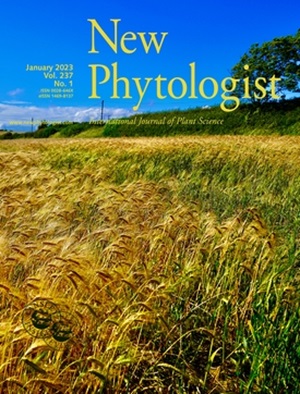Molecular and physiological characterization of brassinosteroid receptor BRI1 mutants in Sorghum bicolor
IF 8.3
1区 生物学
Q1 PLANT SCIENCES
引用次数: 0
Abstract
- The high sequence and structural similarities between BRASSINOSTEROID INSENSITIVE 1 (BRI1) brassinosteroid (BR) receptors of Arabidopsis (AtBRI1) and sorghum (SbBRI1) prompted us to study the functionally conserved roles of BRI1 in both organisms.
- Introducing sorghum SbBRI1 in Arabidopsis bri1 mutants restores defective growth and developmental phenotypes to wild-type levels.
- Sorghum mutants for SbBRI1 show defective BR sensitivity and impaired plant growth and development throughout the entire sorghum life cycle. Embryonic analysis of sorghum primary root techniques permits to trace back root growth and development to early stages in an unprecedented way, revealing the functionally conserved roles of the SbBRI1 receptor in BR perception during meristem development. RNA-seq analysis uncovers the downstream regulation of the SbBRI1 pathway in cell wall biogenesis during cell growth.
- Together, these results uncover that the sorghum SbBRI1 protein plays functionally conserved roles in plant growth and development, while encouraging the study of BR pathways in sorghum and its implications for improving resilience in cereal crops.
求助全文
约1分钟内获得全文
求助全文
来源期刊

New Phytologist
生物-植物科学
自引率
5.30%
发文量
728
期刊介绍:
New Phytologist is an international electronic journal published 24 times a year. It is owned by the New Phytologist Foundation, a non-profit-making charitable organization dedicated to promoting plant science. The journal publishes excellent, novel, rigorous, and timely research and scholarship in plant science and its applications. The articles cover topics in five sections: Physiology & Development, Environment, Interaction, Evolution, and Transformative Plant Biotechnology. These sections encompass intracellular processes, global environmental change, and encourage cross-disciplinary approaches. The journal recognizes the use of techniques from molecular and cell biology, functional genomics, modeling, and system-based approaches in plant science. Abstracting and Indexing Information for New Phytologist includes Academic Search, AgBiotech News & Information, Agroforestry Abstracts, Biochemistry & Biophysics Citation Index, Botanical Pesticides, CAB Abstracts®, Environment Index, Global Health, and Plant Breeding Abstracts, and others.
 求助内容:
求助内容: 应助结果提醒方式:
应助结果提醒方式:


